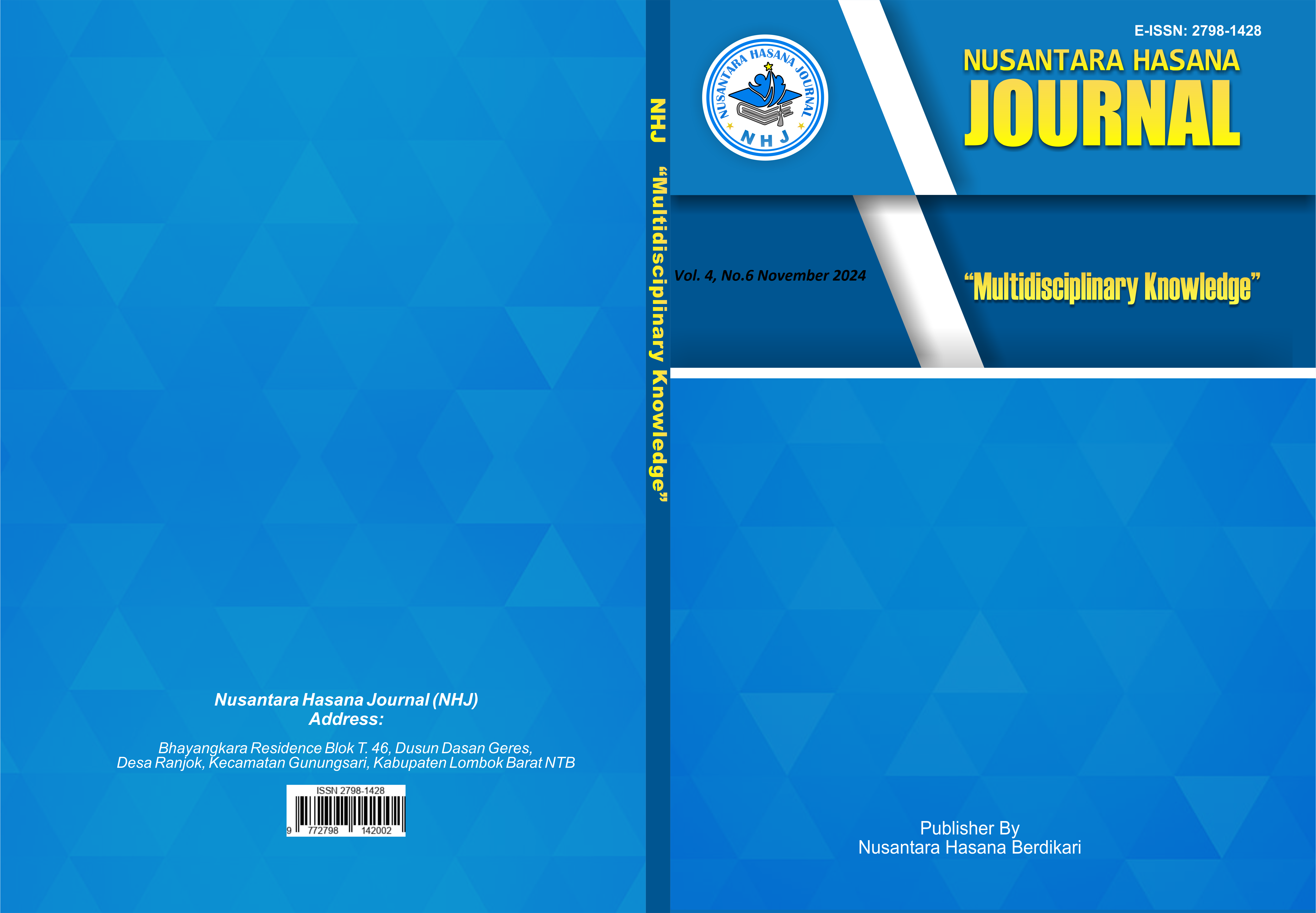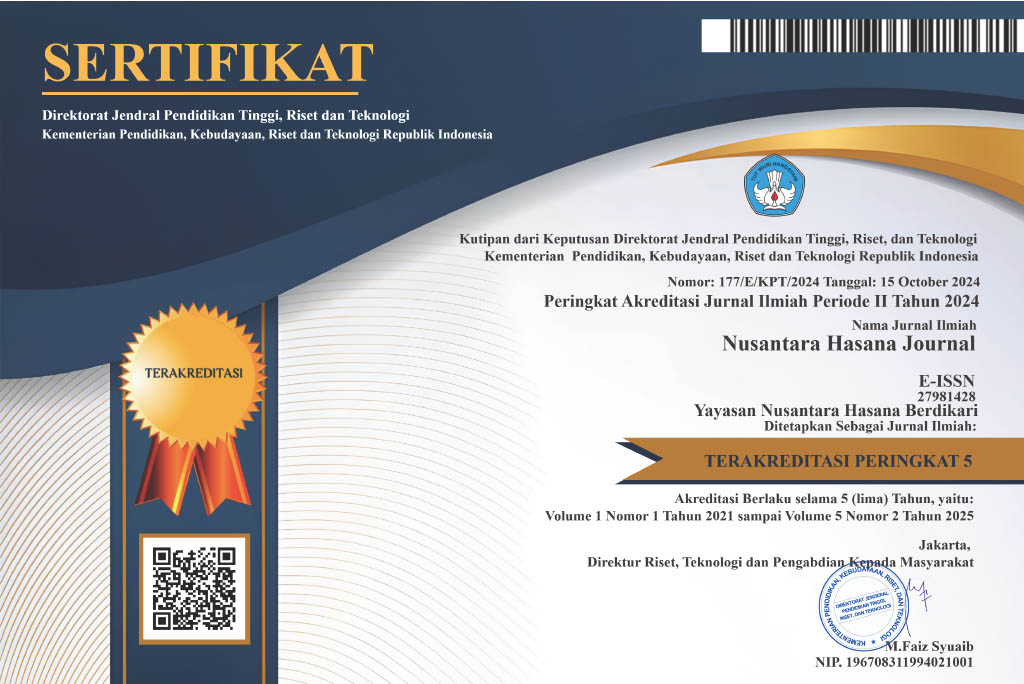PREVALENSI DIABETES MELLITUS TIPE 2 PADA ANAK DAN REMAJA (STUDI LITERATUR)
DOI:
https://doi.org/10.59003/nhj.v4i6.1254Keywords:
Type 2 Diabetes Mellitus; Children; Clinical symptoms; Screening; Comorbidities; ManagementAbstract
Type 2 Diabetes Mellitus is a long-term medical illness marked by high blood sugar levels caused by the body's ineffective use of insulin. The increasing frequency of this problem in not just adults but also in children and adolescents is causing alarm. An overview of Type 2 Diabetes Mellitus detection, diagnosis, treatment, and risk factors is intended to be provided by this review of the literature. The review's research sources come from a number of respected scientific periodicals.The information included in this literature review comes from a variety of scientific papers that have been published in the recent five to ten years in both domestic and foreign journals. Using the following keywords, a comprehensive search of several databases, including PubMed, the Cochrane Library, and Google Scholar, produced these articles: "type 2 diabetes mellitus," "children," "adolescents," "epidemiology," and "risk." The findings indicate that Type 2 Diabetes Mellitus is becoming more common in children and teenagers, particularly in developing nations. Unhealthy lifestyle choices such an unbalanced diet and inactivity are associated with this trend (Rahmayunita et al., 2023). Significant concern also surrounds the long-term consequences of Type 2 Diabetes Mellitus in children and adolescents, which include retinopathy, nephropathy, cardiovascular disease, and neuropathy (Rahmayunita et al., 2023; Wijayanti et al., 2020; Kusumastuti et al., 2023; Andriyani et al., 2022).Medical teams, parents, and the patients themselves must work together to manage Type 2 Diabetes Mellitus in children and adolescents. For this condition to be prevented and controlled from progressing, early detection, suitable treatment, and lifestyle modifications toward healthy habits are essential.
Downloads
References
Abdullah, D. (2024) ‘Literatur Review Terapi Herbal Pada Penyakit Diabetes Anak’, Journal of Public Health Science (JoPHS), 1(2), pp. 110–118.
Care, D. and Suppl, S. S. (2020) ‘Children and adolescents: Standards of medical care in diabetes- 2020’, Diabetes Care, 43(January), pp. S163–S182. doi: 10.2337/dc20-S013.
Edelstein, S. L. et al. (2018) ‘Metabolic contrasts between youth and adults with impaired glucose tolerance or recently diagnosed type 2 diabetes: I. Observations using the hyperglycemic Clamp’, Diabetes Care, 41(8), pp. 1696–1706. doi: 10.2337/dc18-0244.
Gonzalez, E. et al. (2022) ‘Central Diabetes Insipidus Masked by Uncontrolled Diabetes Mellitus: A Challenging Case Managed With Indapamide’, Cureus, 14(2), pp. 1–5. doi: 10.7759/cureus.21897.
Hannon, T. S. et al. (2017) ‘Effectiveness of computer automation for the diagnosis and management of childhood type 2 diabetes a randomized clinical trial’, JAMA Pediatrics, 171(4), pp. 327–334. doi: 10.1001/jamapediatrics.2016.4207.
Jensen, E. T. et al. (2021) ‘Increase in prevalence of diabetic ketoacidosis at diagnosis among youth with type 1 diabetes: The SEARCH for diabetes in youth study’, Diabetes Care, 44(7), pp. 1573–1578. doi: 10.2337/dc20-0389.
Liu, J. et al. (2020) ‘Trends in the incidence of diabetes mellitus: results from the Global Burden of Disease Study 2017 and implications for diabetes mellitus prevention’, BMC Public Health. BMC Public Health, 20(1), pp. 1–12. doi: 10.1186/s12889-020-09502-x.
Nadeau, K. J. et al. (2016) ‘Youth-onset type 2 diabetes consensus report: Current status, challenges, and priorities’, Diabetes Care, 39(9), pp. 1635–1642. doi: 10.2337/dc16-1066.
Patti, G. et al. (2022) ‘Approach to the Pediatric Patient: Central Diabetes Insipidus’, Journal of Clinical Endocrinology and Metabolism, 107(5), pp. 1407–1416. doi: 10.1210/clinem/dgab930.
Piko, P. et al. (2021) ‘Impact of genetic factors on the age of onset for type 2 diabetes mellitus in addition to the conventional risk factors’, Journal of Personalized Medicine, 11(1), pp. 1–17. doi: 10.3390/jpm11010006.
Serbis, A. et al. (2021) ‘Diagnosis, treatment and prevention of type 2 diabetes mellitus in children and adolescents’, World Journal of Diabetes, 12(4), pp. 344–365. doi: 10.4239/wjd.v12.i4.344.
Stevens, L. M., Lynm, C. and Glass, R. M. (2001) ‘Type 2 diabetes mellitus in children’, Jama, 286(12), p. 1536. doi: 10.1001/jama.286.12.1536.
Downloads
Published
How to Cite
Issue
Section
License
Copyright (c) 2024 Gangga Mahatma

This work is licensed under a Creative Commons Attribution-NonCommercial-ShareAlike 4.0 International License.
NHJ is licensed under a Creative Commons Attribution-NonCommercial-ShareAlike 4.0 International License.
Articles in this journal are Open Access articles published under the Creative Commons CC BY-NC-SA License This license permits use, distribution and reproduction in any medium for non-commercial purposes only, provided the original work and source is properly cited.
Any derivative of the original must be distributed under the same license as the original.
























